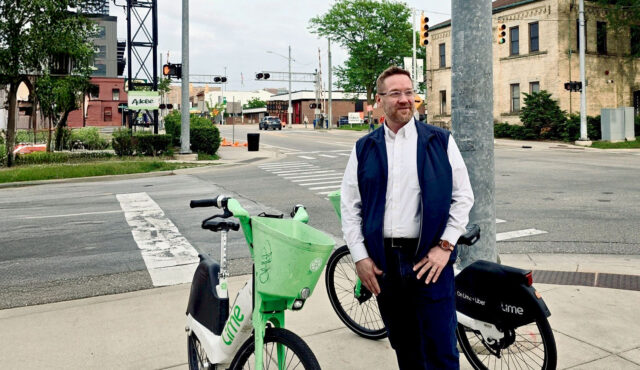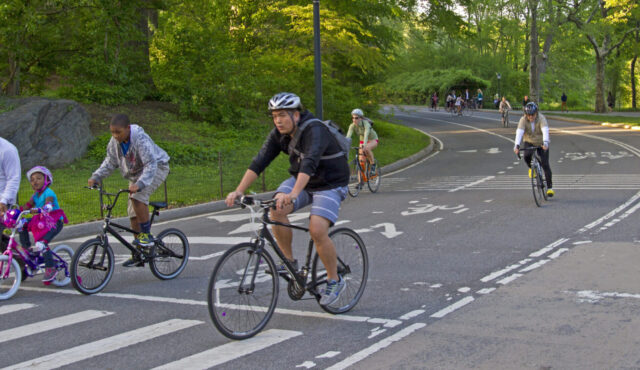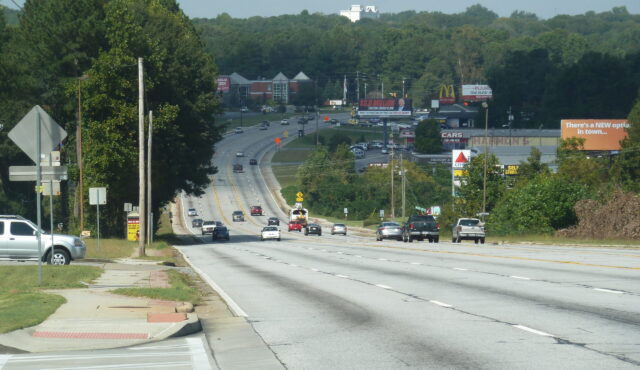Look at a bike lane in a major city today, and you won’t just see traditional pedal bikes. You are quite likely to find e-scooters, e-bikes, trikes, motorized skateboards, hoverboards, and others. A recent report from the North American Bikeshare Association notes that 124,000 of the 194,000 vehicles deployed across North America in shared micromobility systems were e-scooters (112k) or E-bikes (12k); and who knows what new forms of mobility people may be using in bike lanes in coming years? These kinds of vehicles and devices are taking on even greater importance during the Covid-19 pandemic, as communities look for transportation options that allow people to maintain physical distance from each other. As a result, cities are actively rethinking and rebalancing their public streets and spaces.
The expanded use of bike lanes presents our industry with exciting opportunities: a broader user base means greater demand and more support for developing world class bike networks. For example, the Portland Bureau of Transportation just released a report showing that high-quality bike infrastructure increases e-scooter usage and keeps scooters off sidewalks.
Yet new users also bring new challenges as bike facilities are tasked with serving greater numbers of people with a greater range of needs and characteristics. Different types of users mean different speeds, kinetic energies, acceleration and deceleration capabilities, and different vehicle shapes and sizes. As new vehicles proliferate, how do we make it clear which vehicles are welcome in bike lanes, and which are not?
Time for New Terminology?
In 2018, Human Transit’s Jarett Walker and urban policy consultant Sarah Iannarone raised the question: is “bike lane” still the right term? Is it time to think about new terminology? The suggestions started rolling in: LIT Lanes (short for Light Individual Transportation), micromobility lanes, protected mobility lanes, and others.
Some cities have begun experimenting with new terminology that explicitly acknowledges the wider variety of vehicles using bike networks. Atlanta has adopted LIT Lanes as the preferred term in place of “bike lanes;” Pittsburgh’s 2020 draft Bike(+) Master Plan replaces “bike” with “bike(+)” and “bike lane” with “bike(+) lane” throughout, defining the “plus” to include vehicles that are lightweight (less than 150 pounds) and low speed (less than 20 miles per hour).
At Toole Design we have been engaging in spirited internal debate, grappling with these questions as we chart these waters with cities like Pittsburgh.
What Do Toole Design Staff Think?
Do we need new terminology? If so, what are the pros and cons of various terms that have been suggested? These are the questions that we asked our coworkers. Out of the rumble that resulted, a consensus emerged. The top results are listed below; scroll to the bottom of this post for a table laying out the pros and cons of the full set of surveyed terms.
Bike Lane: Still the Gold Standard
Our staff concluded that “Bike Lane” is still the best term. It is flexible, useful, adaptable, and appropriate, and most jurisdictions will want to retain it for now.
- The general public already understands and feels comfortable with “bike lane.”
- “Bike lane” reflects the majority of users, and subtly emphasizes that the primary user is nonmotorized.
- Thousands of laws, signs, guides, maps, and plans already use this terminology.
- Language change works best when it happens organically; top-down language change can be problematic and often won’t catch on.
- Much as people understand that their “phone” does much more than make calls, people are able to understand that the function of a bike lane is expanding.
Bike+ Lane: An Intuitive New Terminology
For cities that want to explicitly change their terminology, we are big fans of Bike+, which builds intuitively on language people already know and are comfortable with. Bike+ lanes retain the benefits of “bike lane” while explicitly acknowledging the expanded functions of the lanes. There is also the practical advantage that current signage and pavement markings would continue to be appropriate. Bike+ is our personal top choice if new terminology is necessary or desired.
LIT Lane: Divisive, but One to Watch
“LIT Lane” was divisive. Some of our staff are big fans, seeing the term as short and catchy, and noting that it is already catching on in some parts of the multimodal planning world. But others had big concerns about a term they see as jargony, wonkish, confusing, and unlikely to catch on with the general public; there were also concerns about the slang usage of “lit” to mean drunk. This term has many boosters however, and it will be one to watch as cities continue to experiment.
Looking Forward
This conversation is far from over. Terminology is always changing in our rapidly evolving field, and we are excited to keep watching and working with cities as they try out new names and configurations for their bike lanes. Maybe a new term will go viral and a few years from now “bike lanes” will seem antiquated and quaint.
We look forward to continuing to watch this conversation and participate in it as it evolves! And in the meantime, as planners and designers, we will work to ensure that we are meeting the expanding demands on bike lanes and networks to create a safe and comfortable experience for all users.
What do you think?
- Do we need a new term for bike lanes? Why or why not? What is your preferred term?
- How do e-scooters and other light vehicles change the way we need to plan, design, and think about bike lanes?
Tweet at us (@tooledesign) using the hashtag #newnameforbikelanes and tell us what you think.
Full Results:
 of the staff survey. The two-page report identifies the pros and cons of seven possible names for bike lanes.
of the staff survey. The two-page report identifies the pros and cons of seven possible names for bike lanes.



